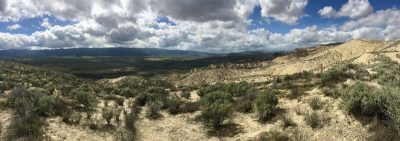Trump Administration Again OKs Oil Drilling in California’s Carrizo Plain National Monument

On the eve of a holiday weekend and during a global pandemic, the Trump administration last week approved a new oil well and pipeline in Carrizo Plain National Monument. It would be the first well drilled in the monument since it was established in 2001.
The Bureau of Land Management originally approved the well and pipeline two years ago but withdrew that approval in July 2019 after Los Padres ForestWatch and Center for Biological Diversity filed objections. The conservation groups cited the well’s potential harm to wildlife, views and the climate.
“While many of us are worried about basic needs during a time of crisis, the Trump administration is busy catering to the oil industry at the expense of people and the planet,” said ForestWatch Executive Director Jeff Kuyper. “The Carrizo Plain National Monument is one of our region’s most precious wild places and deserves better than this.”
The oil well and pipeline would harm threatened and endangered wildlife and mar scenic views. This fossil fuel development would violate several laws, including the Endangered Species Act and National Environmental Policy Act, as well as the monument’s resource-management plan.
The proposed well site is located at the base of the Caliente Mountains, inside the western boundary of Carrizo Plain National Monument. The area is home to several protected species, including threatened San Joaquin antelope squirrels, endangered San Joaquin kit foxes and a threatened flowering plant called the Kern mallow. Endangered California condors also visit this area with increasing frequency as they continue to expand into their historic range.
“The Trump administration’s irrational decision to approve oil drilling in this spectacular place ignores climate change, imperils rare wildlife, and contradicts the monument’s conservation purpose,” said Lisa Belenky, a senior attorney at the Center for Biological Diversity. “Instead of expanding oil and gas drilling, we need to keep dirty fossil fuels in the ground and turn to renewable energy sources.”
The oil well would be drilled on an existing oil pad that hasn’t produced oil since the 1950s. In 2016 the BLM approved the oil company’s request to formally abandon the pad and remove an old well, pipelines and other equipment from the site. The company also pledged to recontour and reseed the pad and a half-mile access road leading to it, restoring the area to natural conditions. The work was never done, and now the BLM is attempting to backtrack on these abandonment plans by approving further development.
The new well is located on an existing oil lease that was “grandfathered” in under the monument proclamation signed by President Bill Clinton in 2001, but new development is supposed to comply with more stringent standards.
The well would be drilled in the Russell Ranch Oil Field, which covers approximately 1,500 acres of the monument and adjacent private land. In 2018 the field produced only 128 barrels of oil per day ― 0.03% of the state’s total oil production and one of the lowest-producing oilfields in the state. The field is reportedly nearing the end of its useful life.
When the California BLM withdrew its original approval of the well last year, it directed its Bakersfield Field Office to substantially revise its environmental assessment and consult with the U.S. Fish and Wildlife Service. But the BLM’s new decision continues to disregard significant environmental impacts and potential harm to the conservation values of the monument.
About the Carrizo Plain
Carrizo Plain National Monument is a vast expanse of golden grasslands and stark ridges known for their springtime wildflower displays. Often referred to as “California’s Serengeti,” it is one of the last undeveloped remnants of the southern San Joaquin Valley ecosystem.
The Carrizo Plain is critical for the long-term conservation of this dwindling ecosystem, linking these lands to other high-value habitat areas like the Los Padres National Forest, Salinas Valley, Cuyama Valley and Bitter Creek National Wildlife Refuge in western Kern County.
Honoring the area’s high biodiversity, limited human impacts and rare geological and cultural features, the Carrizo Plain was declared a national monument in 2001. It includes more than 206,000 acres of public lands ― perhaps the largest native grassland remaining in all of California.
*
Note to readers: please click the share buttons above or below. Forward this article to your email lists. Crosspost on your blog site, internet forums. etc.
Featured image: Inside the western boundary of Carrizo Plain National Monument, in the area where the Bureau of Land Management has approved an oil well and pipeline. Photo credit: Los Padres ForestWatch.

